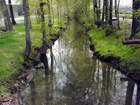In February 2005, twenty people were injured when a 20- ton corporate jet aborted takeoff on Runway 6, crossed Route 46 about 300 feet and crashed into Strawberry Warehouse at the corner of Huyler and Route 46. [Story] About eight months later, the Port Authority Board of Commissioners authorized the design and construction of beds made of aerated cement blocks that crumble under the weight of an aircraft to stop it safely and quickly in the event it overruns a runway at Teterboro Airport. The Board’s action authorizes installation of a 170-foot-wide, 300-foot-long arrestor bed at the end of the 6,015 foot Runway 6 at Teterboro. Additionally, Port Authority Chairman Anthony R. Coscia has expressed his commitment to install another EMAS at the end of Teterboro’s 7,000 foot Runway 19, which sits near a Moonachie neighborhood. That work would begin once nearby Redneck Avenue is relocated slightly east. The total cost for the installation of EMAS on Runway 6 is estimated at $11 million, and $9 million for the subsequent installation on Runway 19. The technology, known as the Engineered Materials Arresting System (EMAS), was pioneered by the Port Authority and the Federal Aviation Administration, and has proven effective at John F. Kennedy International Airport, where the world’s first EMAS was installed in 1996. In 1999, it safely stopped a commuter plane with 27 passengers aboard. In 2003, a cargo jet carrying three crew members was successfully stopped, and earlier this year, a second cargo plane with three crew members aboard also was safely halted. The first system will be installed at Teterboro by the end of 2006. Arrestor beds are lightweight concrete blocks designed to slow or stop jets that overshoot a runway. The blocks are stacked at the foot of the runway and gradually slope up. The beds are light enough to crush under a jet’s landing gear, but heavy enough to slow or stop a jet. The beds can withstand the weight of rescue trucks responding to an accident. Port Authority Executive Director Kenneth J. Ringler Jr. said, "The technology has proven effective in bringing aircraft to a safe and complete stop. It could be compared to driving a vehicle into gradually deepening snow. The bed, made of collapsible aerated cement blocks, rises from 0 to 30 inches and can safely stop an aircraft traveling up to 80 mph." "Today’s Board action demonstrates our continued commitment to investing in state-of-the-art safety improvements at Teterboro," said Coscia, who noted the project was originally scheduled for completion in mid-2007. "We are going to complete this project on an accelerated schedule because it simply needs to get done now. One of our primary objectives as a transportation agency is ensuring the highest possible levels of safety at all of our facilities. From continually improving emergency response by working with local responders and placing Port Authority Police in charge of security and on-airport response, to the purchase of technologically advanced firefighting equipment and now the installation of EMAS, investing in safety at Teterboro and all of our facilities is one of the Port Authority’s and my own highest priorities." Port Authority Vice Chairman Charles A. Gargano said, "the Port Authority is the world’s leader in EMAS technology. We designed the technology with the FAA and installed the world’s first system at JFK in 1996. We currently have nearly 20 percent of all such systems in the entire country. No airport operator has a more aggressive program to install EMAS than the Port Authority." Teterboro Airport handles about 200,000 aircraft annually. The facility is a 24 hour public use, although it adheres to a voluntary nightly curfew from 12:00 a.m. to 6:00 a.m. The airport imposes a 100,000 weight restriction. The airport holds an ISO 9002 certification. ######
|









